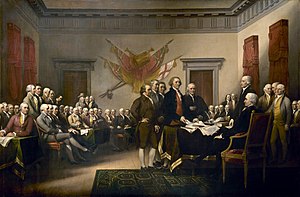American Revolution/The Declaration of Independence
Troubles[edit | edit source]
As relations between Great Britain and its American colonies became increasingly strained, the Americans set up a shadow government in each colony, with a Continental Congress and Committees of Correspondence linking these shadow governments. As soon as fighting broke out in April 1775, these shadow governments took control of each colony and ousted all the royal officials. Sentiment for outright independence grew rapidly in response to British actions; the options were clarified by Thomas Paine's pamphlet Common Sense, released in January 1776.

Draft[edit | edit source]
The "Lee Resolution" presented by Richard Henry Lee of Virginia on June 7, 1776, read (in part): '"Resolved: That these united Colonies are, and of right ought to be, free and independent States, that they are absolved from all allegiance to the British Crown, and that all political connection between them and the State of Great Britain is, and ought to be, totally dissolved."' The Second Continental Congress formed a committee, consisting of John Adams of Massachusetts, Benjamin Franklin of Pennsylvania, Thomas Jefferson of Virginia, Robert R. Livingston of New York, and Roger Sherman of Connecticut (the "Committee of Five"), to draft a suitable declaration to frame this resolution. The committee decided that Jefferson would write the draft, which he showed to Franklin and Adams. Prior to deciding on Jefferson, both Adams and Franklin turned down the offer, citing that if they wrote it people would read it with a biased eye. Franklin himself made at least 48 corrections, including changing the slogan "Life, Liberty and Property" to "Life, Liberty, and the pursuit of Happiness." Jefferson then produced another copy incorporating these changes, and the committee presented this copy to the Continental Congress on June 28, 1776.
On July 2 the Congress voted for independence by approving the Lee Resolution, twelve delegations voting in favor while the New York delegation abstained. (New York did not cast its vote for the Lee Resolution until July 9.)
The full Declaration was reworked somewhat in general session of the Continental Congress. Congress, meeting in Independence Hall in Philadelphia, finished revising Jefferson's draft statement on July 4, approved it, and sent it to a printer. At the signing, Benjamin Franklin is quoted as having replied to a comment by Hancock that they must all hang together: "Yes, we must, indeed, all hang together, or most assuredly we shall all hang separately," a play on words indicating that failure to stay united and succeed would lead to being tried and executed, individually, for treason.

The News Arrives[edit | edit source]
After its adoption by Congress on July 4, a handwritten draft signed by the President of Congress John Hancock and the Secretary Charles Thomson was then sent a few blocks away to the printing shop of John Dunlap. Through the night between 150 and 200 copies were made, now known as "Dunlap broadsides". The first public reading of the document was by John Nixon in the yard of Independence Hall on July 8. One was sent to George Washington on July 6, who had it read to his troops in New York on July 9. A copy reached London on August 10. The 25 Dunlap broadsides still known to exist are the oldest surviving copies of the document. The original handwritten copy has not survived.
On July 19, Congress ordered a copy be "engrossed" (hand written in fair script on parchment by an expert penman) for the delegates to sign. This engrossed copy was produced by Timothy Matlack, assistant to the secretary of Congress. Most of the delegates signed it on August 2, 1776, in geographic order of their colonies from north to south, though some delegates were not present and had to sign later. Late signers were Elbridge Gerry, Oliver Wolcott, Lewis Morris, Thomas McKean, and Matthew Thornton (who, because of a lack of space, was unable to place his signature on the top right of the signing area with the other New Hampshire delegates, William Whipple and Josiah Bartlett, and had to place his signature on the lower right). As new delegates joined the congress, they were also allowed to sign. A total of 56 delegates eventually signed.
Three delegates never signed. Robert R. Livingston, a member of the original drafting committee, was present for the vote on July 2 but returned to New York before the August 2 signing. John Dickinson, a member of the Continental Congress from Pennsylvania, refused to sign. He was against separation from Great Britain and labored to change the language of the Declaration of Independence to leave open the possibility of a reconciliation. Thomas Lynch voted for the Declaration but could not sign it because of illness.